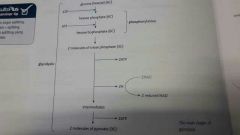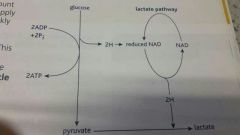![]()
![]()
![]()
Use LEFT and RIGHT arrow keys to navigate between flashcards;
Use UP and DOWN arrow keys to flip the card;
H to show hint;
A reads text to speech;
8 Cards in this Set
- Front
- Back
- 3rd side (hint)
|
Aerobic respiration |
Glucose + oxygen > Carbon Dioxide + water |
|
|
|
Anaerobic respiration |
Glucose > lactic acid + adenosine triphosphate |
|
|
|
ATP |
Energy required to add a third phosphate bond to ADP Hydrolysis releases energy |
|
|
|
Glycolysis |

|
Involves phosphorylation, crates pyruvate from glucose |
|
|
Anaerobic respiration |

NAD is needed to continue glycolysis In anaerobic respiration, NAD is formed by lactate production |
Creates lactate and NAD |
|
|
Lactic acid |
Formed by lactate, lowers the pH of the solution, build up can cause muscle cramp- once aerobic respiration resumes, turned back into lactate and pyruvate by Krebs cycle- OXYGEN DEBT |
|
|
|
Stages of aerobic respiration |
Stage 1 Pyruvate> carbon dioxide and Hydrogen Stage 2 Oxidative phosphorylation ATP synthesis on electron transport chain |
|
|
|
Kerbs cycle |

Each acetylCoA generates: 3 reduced NAD 1 reduced FAD 2 CO2 1 ATP 1 4C compound- used to restart the cycle
|
|

